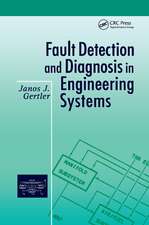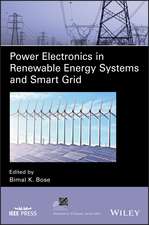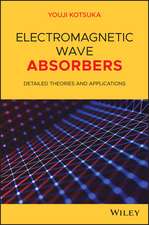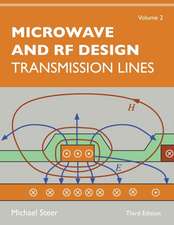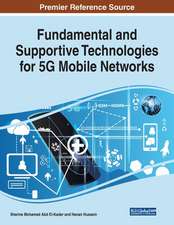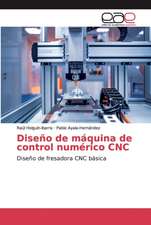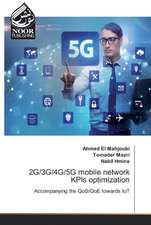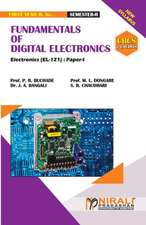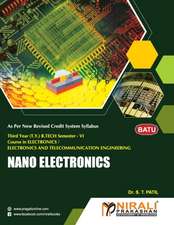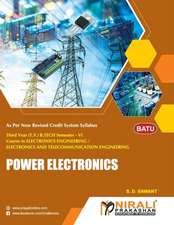Smart Grid and Enabling Technologies: IEEE Press
Autor SS Refaaten Limba Engleză Hardback – 25 aug 2021
As the relationship between fossil fuel use and climate change becomes ever clearer, the search is on for reliable, renewable and less harmful sources of energy. Sometimes called the "electronet" or the "energy Internet," smart grids promise to integrate renewable energy, information, and communication technologies with the existing electrical grid and deliver electricity more efficiently and reliably.
Smart Grid and Enabling Technologies delivers a complete vision of smart grid technology and applications, including foundational and fundamental technologies, the technology that enables smart grids, the current state of the industry, and future trends in smart energy. The book offers readers thorough discussions of modern smart grid technology, including advanced metering infrastructure, net zero energy buildings, and communication, data management, and networks in smart grids.
The accomplished authors also discuss critical challenges and barriers facing the smart grid industry as well as trends likely to be of importance in its future development. Readers will also benefit from the inclusion of:
- A thorough introduction to smart grid architecture, including traditional grids, the fundamentals of electric power, definitions and classifications of smart grids, and the components of smart grid technology
- An exploration of the opportunities and challenges posed by renewable energy integration
- Practical discussions of power electronics in the smart grid, including power electronics converters for distributed generation, flexible alternating current transmission systems, and high voltage direct current transmission systems
- An analysis of distributed generation
Din seria IEEE Press
- 5%
 Preț: 599.39 lei
Preț: 599.39 lei - 20%
 Preț: 684.17 lei
Preț: 684.17 lei - 14%
 Preț: 743.46 lei
Preț: 743.46 lei - 24%
 Preț: 600.44 lei
Preț: 600.44 lei - 24%
 Preț: 1226.90 lei
Preț: 1226.90 lei - 24%
 Preț: 667.14 lei
Preț: 667.14 lei - 24%
 Preț: 672.03 lei
Preț: 672.03 lei - 24%
 Preț: 741.52 lei
Preț: 741.52 lei - 24%
 Preț: 546.23 lei
Preț: 546.23 lei - 24%
 Preț: 572.09 lei
Preț: 572.09 lei - 24%
 Preț: 706.11 lei
Preț: 706.11 lei - 24%
 Preț: 618.96 lei
Preț: 618.96 lei - 24%
 Preț: 704.87 lei
Preț: 704.87 lei - 24%
 Preț: 702.62 lei
Preț: 702.62 lei - 24%
 Preț: 617.44 lei
Preț: 617.44 lei - 24%
 Preț: 612.64 lei
Preț: 612.64 lei - 20%
 Preț: 446.57 lei
Preț: 446.57 lei - 24%
 Preț: 707.87 lei
Preț: 707.87 lei - 24%
 Preț: 695.85 lei
Preț: 695.85 lei - 14%
 Preț: 858.78 lei
Preț: 858.78 lei -
 Preț: 415.98 lei
Preț: 415.98 lei - 9%
 Preț: 1010.21 lei
Preț: 1010.21 lei - 9%
 Preț: 1499.89 lei
Preț: 1499.89 lei - 9%
 Preț: 806.07 lei
Preț: 806.07 lei - 9%
 Preț: 1069.47 lei
Preț: 1069.47 lei - 9%
 Preț: 1485.82 lei
Preț: 1485.82 lei - 9%
 Preț: 1020.25 lei
Preț: 1020.25 lei - 9%
 Preț: 930.31 lei
Preț: 930.31 lei - 9%
 Preț: 1117.45 lei
Preț: 1117.45 lei - 20%
 Preț: 723.20 lei
Preț: 723.20 lei - 9%
 Preț: 923.82 lei
Preț: 923.82 lei - 9%
 Preț: 994.01 lei
Preț: 994.01 lei - 9%
 Preț: 963.51 lei
Preț: 963.51 lei - 9%
 Preț: 1969.97 lei
Preț: 1969.97 lei - 9%
 Preț: 742.90 lei
Preț: 742.90 lei - 9%
 Preț: 1021.22 lei
Preț: 1021.22 lei - 9%
 Preț: 997.70 lei
Preț: 997.70 lei - 9%
 Preț: 970.56 lei
Preț: 970.56 lei - 9%
 Preț: 781.15 lei
Preț: 781.15 lei - 9%
 Preț: 1162.23 lei
Preț: 1162.23 lei - 9%
 Preț: 1030.34 lei
Preț: 1030.34 lei - 9%
 Preț: 815.85 lei
Preț: 815.85 lei - 9%
 Preț: 1130.31 lei
Preț: 1130.31 lei - 9%
 Preț: 1560.74 lei
Preț: 1560.74 lei - 9%
 Preț: 1289.30 lei
Preț: 1289.30 lei - 9%
 Preț: 1036.75 lei
Preț: 1036.75 lei - 9%
 Preț: 968.96 lei
Preț: 968.96 lei - 9%
 Preț: 1130.63 lei
Preț: 1130.63 lei - 9%
 Preț: 1010.82 lei
Preț: 1010.82 lei - 9%
 Preț: 1237.02 lei
Preț: 1237.02 lei
Preț: 854.33 lei
Preț vechi: 938.83 lei
-9% Nou
Puncte Express: 1281
Preț estimativ în valută:
163.47€ • 170.68$ • 135.30£
163.47€ • 170.68$ • 135.30£
Carte tipărită la comandă
Livrare economică 04-18 aprilie
Preluare comenzi: 021 569.72.76
Specificații
ISBN-13: 9781119422310
ISBN-10: 1119422310
Pagini: 512
Dimensiuni: 173 x 249 x 33 mm
Greutate: 1 kg
Editura: Wiley
Seria IEEE Press
Locul publicării:Chichester, United Kingdom
ISBN-10: 1119422310
Pagini: 512
Dimensiuni: 173 x 249 x 33 mm
Greutate: 1 kg
Editura: Wiley
Seria IEEE Press
Locul publicării:Chichester, United Kingdom
Cuprins
About the Authors
Acknowledgements
Preface
List of Abbreviations
* 1. Smart Grid Architectural Overview
1.1 Introduction
1.2 Fundamentals of Electric Power system
1.2.1 Electrical Power Generation
1.2.2 Electric Power Transmission
1.2.3 Electric Power Distribution
1.3 More limitations of the traditional power grid
1.3.1 Lack of circuit capacity and aging assets
1.3.2 Operation Constrains
1.3.3 Security of Supply
1.3.4 Respond to national initiatives
1.4 Smart Grid Definition
1.5 Smart Grid Characteristics
1.5.1 Achieve flexibility in the network topology
1.5.2 Improved efficiency
1.5.3 Transportation Electrification
1.5.4 Demand response support
1.5.5 Improvement in Reliability and Power Quality
1.5.6 Market-enabling
1.6 Moving towards Future grid
1.6.1 Electrification
1.6.2 Decentralization
1.6.3 Digitalization
1.7 The transformation from the traditional grid to smart grid
1.8 Smart Grid Enabling Technologies
1.9 Smart Grid Architecture
1.9.1 Distributed Generation
1.9.2 Energy Storage
1.9.3 Demand Response
1.9.4 Integrated communications
1.9.4.1 Communication Networks
1.9.4.2 Power Line Communication (PLC)
1.9.4.3 Standardization
1.9.5 Customer Engagement
1.9.6 Sensors and PMU Units
1.9.7 Smart Meters
1.10Classification of Smart Grid Control
1.11Smart Grid Challenges
1.11.1 Accessibility and acceptability
1.11.2 Accountability
1.11.3 Controllability
1.11.4 Interoperability
1.11.5 Interchangeability
1.11.6 Maintainability
1.11.7 Optimality
1.11.8 Security
1.11.9 Upgradability
1.12Organization of the Book
* 2. Renewable Energy: Overview, Opportunities and Challenges
2.1 Introduction
2.2 Description of Renewable Energy Sources
2.2.1 Bioenergy Energy
2.2.2 Geothermal Energy
2.2.3 Hydropower Energy
2.2.4 Marine Energy
2.2.5 Solar Energy
2.2.5.1 Photovoltaic
2.2.5.2 Concentrated Solar Power
2.2.5.3 Solar Thermal Heating and Cooling
2.2.6 Wind Energy
2.3 Renewable Energy: Growth, Investment, Benefits and Deployment
2.4 Smart Grid Enable Renewables
2.5 Conclusion
2.6 References
* 3. Power Electronics Converters for Distributed Generation
3.1 An overview of distributed generation systems with power electronics
3.1.1 Photovoltaic technology
3.1.2 Wind power technology
3.1.3 Energy storage systems
3.2 Power electronics for grid-connected AC smart grid
3.2.1 Voltage-source converters
3.2.2 Multilevel power converters
3.3 Power electronics enabled autonomous AC power systems
3.3.1 Converter level controls in microgrids
3.3.2 System level coordination control
3.4 Power electronics enabled autonomous DC power systems
3.4.1 Converter level controls
3.4.2 System level coordination control
3.5 Conclusion
3.6 References
* 4. Energy Storage Systems as an Enabling Technology for the Smart Grid
4.1 Introduction
4.2 Structure of Energy Storage System
4.3 Energy Storage Systems Classification and Description
4.4 Current State of Energy Storage Technologies
4.5 Techno-Economic Characteristics of Energy Storage Systems
4.6 Selection of Energy Storage Technology for Certain Application
4.7 Energy Storage Applications
4.8 Barriers to the Deployment of Energy Storage
4.9 Energy Storage Roadmap
4.10Conclusion
4.11References
* 5. Microgrids: State of the Art and Future Challenges
5.1 Introduction
5.2 DC Versus AC Microgrid
5.2.1 LVAC and LVDC Networks
5.2.2 AC Microgrid
5.2.3 DC Microgrid
5.3 Microgrid Design
5.3.1 Methodology for the Microgrid Design
5.3.2 Design Considerations
5.4 Microgrid Control
5.4.1 Primary Control Level
5.4.2 Secondary Control Level
5.4.3 Tertiary Control Level
5.5 Microgrid Economics
5.5.1 Capacity Planning
5.5.2 Operations Modeling
5.5.3 Financial Modeling
5.5.4 Barriers to Realizing Microgrids
5.6 Operation of Multi-Microgrids
5.7 Microgrid Benefits
5.7.1 Economic Benefits
5.7.2 Technical Benefits
5.7.3 Environmental Benefits
5.8 Challenges
5.9 Conclusion
5.10References
* 6. Smart Transportation
6.1 Introduction
6.2 Electric Vehicle Topologies
6.2.1 Battery Electric Vehicles
6.2.2 Plug-in Hybrid Electric Vehicles
6.2.3 Hybrid Electric Vehicles
6.2.4 Fuel-Cell Electric Vehicles
6.2.5 Fuel-Cell Electric Vehicles
6.3 Powertrain Architectures
6.3.1 Series HEV Architecture
6.3.2 Parallel HEV Architecture
6.3.3 Series-Parallel HEV Architecture
6.4 Battery Technology
6.4.1 Battery Parameters
6.4.2 Common Battery Chemistries
6.5 Battery Charger Technology
6.5.1 Charging Rates and Options
6.5.2 Wireless Charging
6.6 Vehicle to Grid (V2G) Concept
6.6.1 Unidirectional V2G
6.6.2 Bidirectional V2G
6.7 Barriers to EV Adoption
6.7.1 Technological Problems
6.7.2 Social Problems
6.7.3 Economic Problems
6.8 Trends and Future Developments
6.9 Conclusion
6.10References
* 7. Net Zero Energy Buildings
7.1 Introduction
7.2 Net Zero Energy Building Definition
7.3 Net Zero Energy Building Design
7.4 Net Zero Energy Building: Modelling, Controlling and Optimization
7.5 Net Zero Energy Community
7.6 Net Zero Energy Building: Trends, Benefits, Barriers and Efficiency Investments
7.7 Conclusion
7.8 Reference
* 8. Smart Grid Communication Infrastructures
8.1 Introduction
8.2 Advanced Metering Infrastructure
8.3 Smart Grid Communications
8.3.1 Challenges of SG Communications
8.3.2 Requirements of SG Communications
8.3.3 Architecture of SG Communication
8.3.4 SG Communication technologies
8.4 Conclusion
8.5 References
* 9. Smart Grid Information Security
9.1 Introduction
9.2 Smart Grid Layers
9.2.1 The power system layer
9.2.2 The information layer
9.2.3 The communication layer
9.3 Attacking Smart Grid Network Communication
9.3.1 Physical Layer Attacks.
9.3.2 Data Injection and Replay Attacks.
9.3.3 Network-Based Attacks
9.4 Physical Layer Attacks.
9.4.1 Resilient Industrial Control Systems
9.4.2 Areas of Resilience
9.4.2.1 Human systems
9.4.2.2 Cyber security
9.4.2.3 Complex networks and networked control systems
9.5 Cyber Security Challenges in Smart Grid
9.6 Adopting a Smart Grid Security Architecture Methodology
9.6.1 Smart Grid Security Objectives.
9.6.2 Cyber Security Requirements
9.6.2.1 Attack detection and resilience operations.
9.6.2.2 Identification, and access control.
9.6.2.3 Secure and efficient communication protocols.
9.7 Validating Your Smart Grid
9.8 Threats and Impacts: Consumers and Utility Companies
9.9 Governmental Effort to Secure Smart Grids
9.10Conclusion
9.11References
10. Data Management in Smart Grid
10.1Introduction
10.2 Sources of Data in Smart Grid
10.3Big Data Era
10.4Tools to Manage Big Data
10.4.1 Apache Hadoop
10.4.2 Not Only SQL (NoSQL)
10.4.3 Microsoft HDInsight
10.4.4 Hadoop MapReduce
10.4.5 Cassandra
10.4.6 Storm
10.4.7 Hive
10.4.8 Plotly
10.4.9 Talend
10.4.10 Bokeh
10.4.11 Cloudera
10.5Big Data Integration, Frameworks, and Data Bases
10.6Building the Foundation for Big Data Processing
10.6.1 Big Data Management Platform
10.6.1.1 Acquisition and Recording.
10.6.1.2 Extraction, Cleaning, and Prediction.
10.6.1.3 Big Data Integration
10.6.2 Big Data Analytics Platform
10.6.2.1 Modeling and Analysis
10.6.2.2 Interpretation
10.7Transforming Big Data for High Value Action
10.7.1 Decide what to produce
10.7.2 Source the raw materials
10.7.3 Produce insights with speed
10.7.4 Deliver the goods and act
10.8Privacy Information Impacts on Smart Grid.
10.9Meter Data Management for Smart Grid
10.10 Summary
10.11 References
11. Demand-Management
11.1 Introduction
11.2Demand Response
11.3Demand Response Programs
11.3.1 Load-Response Programs
11.3.2 Price Response Programs
11.4 End User Engagement
11.5Challenges of Demand Response within Smart Grid
11.6Demand-Side Management (DSM)
11.7Demand Side Management Techniques
11.8Demand-Side Management Evaluation
11.9Demand Response Applications
11.10 Summary
11.11 References
12. Business Models for the Smart Grid
12.1The Business Model Concept
12.2The Electricity Value Chain
12.3Electricity Markets
12.4Review of the Previous Proposed Smart Grid Business Models
12.4.1 Timing-Based Business Model
12.4.2 Business Intelligence Model
12.4.3 Business Models for Renewable Energy
12.4.4 Service-oriented Business Models
12.4.5 Prosumer Business Models
12.4.6 Integrated Energy Services Business Model
12.4.7 Future Business Model Levers
12.5Blockchain Based Electricity Market
12.6Conclusion
12.7References
13. Smart Grid Customers' Acceptance and Engagement
13.1Introduction
13.2Customer as one of the Smart Grid Domains
13.3Understanding the Smart Grid Customer
13.4Smart Grid Customer Acceptance
13.5Customer Engagement in the Smart Grid
13.6Challenges for Consumer Engagement, Policy Recommendation and Research Agenda
13.7Conclusion
14. Cloud Computing for Smart Grid
14.1 Introduction
14.2 Overview of Cloud Computing for Smart Grid
14.3 Cloud Computing
14.4 Cloud computing Architecture
14.4.1 1Infrastructure as a Service (IaaS)
14.4.2 2Platform-as-a-Service (PaaS)
14.4.3 Software-as-a-Service (SaaS)
14.5Cloud Computing Applications
14.6Cloud Applications for Smart Grid performance
14.7Cloud Applications for Energy Management
14.8Cloud computing-based power dispatching in smart grid
14.9Cloud computing characteristics in improving SG
14.10 Opportunities and challenges of Cloud Computing in Smart grid
14.11 Multiple perspectives for cloud implementation
14.12 Conclusion
15. On the Pivotal Role of Artificial Intelligence Towards the Evolution of Smart Grids: Advanced Methodologies and Applications
15.1Introduction
15.2Century-old grid and SG transition
15.3AI techniques in smart grid
15.3.1 AI commonly deployed techniques
15.3.1.1 Artificial Neural Networks-based
15.3.1.2 Fuzzy logic-based
15.3.1.3 Ensemble methods-based
15.3.1.4 Genetic algorithms-based
15.3.1.5 Expert Systems-based
15.3.1.6 Support Vector Machines-based
15.3.1.7 Hybrid models-based
15.3.2 Machine Learning Model Evaluation
15.4Major applications of AI in SG
15.4.1 Load forecasting
15.4.2 Alternative energy forecasting
15.4.3 Photovoltaic energy
15.4.4 Wind power
15.4.5 MPPT-based AI
15.4.6 Fault diagnosis-based AI
15.4.7 AI and Cyber smart grid security
15.4.8 Electricity price forecasting
15.5Challenges and future scope
15.6Conclusion
16. Smart Grid Simulation Tools
16.1Introduction
16.2Simulation Approaches
16.2.1 Multi-Domain Simulation
16.2.2 Co-Simulation
16.2.3 Real-Time Simulation and Hardware-in-the-Loop
16.3Review of Smart Grid Planning and Analysis Tools
16.3.1 PSCAD
16.3.2 PowerWorld Simulator
16.3.3 ETAP
16.3.4 DIgSILENT PowerFactory
16.3.5 OpenDSS
16.3.6 GridLab-D
16.3.7 Conclusions
17. Smart Grid Standards and Interoperability
17.1Introduction
17.2Organizations for Smart Grid Standardization
17.2.1 IEC Strategic Group on Smart Grid
17.2.2 Technical Communities and their Subcommittees of IEEE Power and Energy Society (PES)
17.2.3 National Institute of Standards and Technology
17.2.4 National Standard of P.R.C. for Smart Grid
17.3Smart Grid Policies for Standard Developments
17.3.1 United States
17.3.2 Germany
17.3.3 Europe
17.3.4 South Korea
17.3.5 Australia
17.3.6 Canada
17.3.7 Japan
17.3.8 China
17.4Smart Grid Standards
17.4.1 Revenue Metering Information Model
17.4.2 Building Automation
17.4.3 Substation Automation
17.4.4 Powerline Networking
17.4.5 Energy Management Systems
17.4.6 Interoperability Center Communications
17.4.7 Cyber Security
17.4.8 Electric Vehicles
17.5Conclusion
17.6References
18. Smart Grid Challenges and Barriers, Critical Success Factors and Future Vision
18.1Introduction
18.2Structure of modern smart-grids
18.3Concept of reliability in power systems
18.4Smart-grid challenges and barriers
18.4.1 Low inertia issues - Frequency support
18.4.2 Moving towards full/more renewable energies
18.4.3 Protection issues
18.4.4 Control dynamic interactions.
18.4.5 Reliability issues
18.4.6 Marketing
18.5New reliability paradigm in smart-grids
18.5.1 Adequacy
18.5.2 Security
18.5.3 Static security
18.5.4 Dynamic/transient security
18.5.5 Cyber-security
18.6Summary
18.7References
Index [not supplied to follow later




